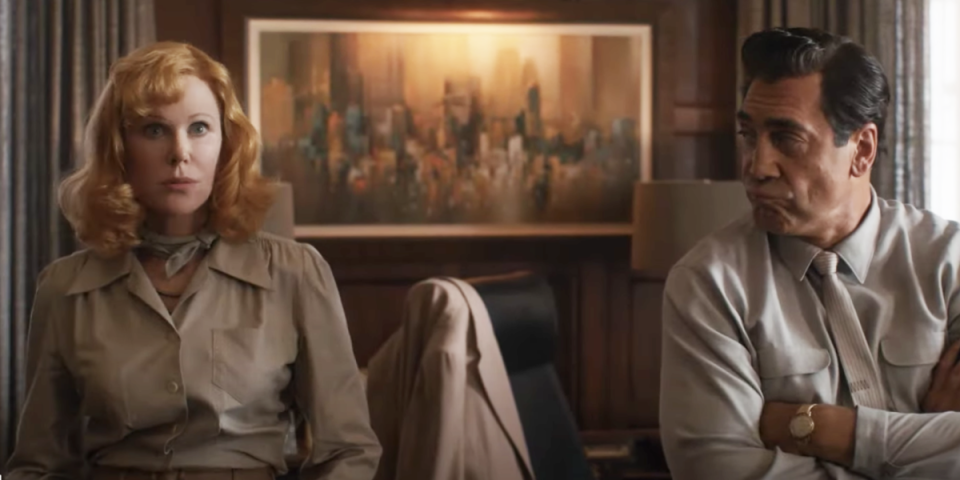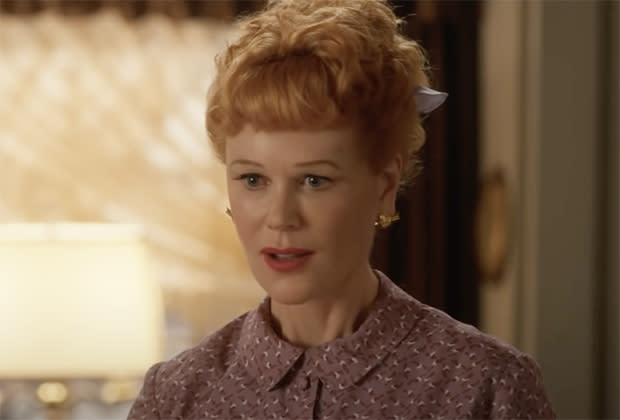‘Being the Ricardos’ Review: Aaron Sorkin Unleashes His Worst Impulses on Awkward Portrait of Lucy and Desi

- Oops!Something went wrong.Please try again later.
- Oops!Something went wrong.Please try again later.
- Oops!Something went wrong.Please try again later.
In retrospect, writer and director Aaron Sorkin’s baffling admission that he doesn’t necessarily think “I Love Lucy” would be considered “funny” today should have caused an even larger fervor than it did (read: a small fervor, at least in social media circles). Sorkin certainly isn’t a stranger to comedy, but his interests — snappy dialogue, twists of fate, jokes about celebs — don’t exactly intersect with the enduring charm of Lucille Ball and Desi Arnaz’s seminal ’50s-era sitcom. Sorkin and Lucy and Desi? It’s a strange pairing even in theory, and still worse in practice, as “Being the Ricardos” offers up some of the least interesting appraisals of not just Lucy and Desi, but of Sorkin himself, plus his stars Nicole Kidman and Javier Bardem.
Typically a razor-sharp writer, Sorkin (who is the sole credited screenwriter of the period drama) seems to trip his way into his ultimate interest here: bolstering the true genius of Ball, even in tough times. That’s a worthy aim, but one made all the weirder by his apparent disdain for Ball’s most pronounced talent: being funny. In the world of “Being the Ricardos,” Ball’s tremendous physical comedy is simply another facet of her iron-willed work ethic and obsession with perfection. While the lines between Lucy Ricardo and Lucille Ball are well-drawn here — thanks to both solid costuming and makeup work, plus Kidman’s brilliant switching between Ball’s icy voice and Lucy’s high-pitched chat — they’re also not particularly compelling. Of course onscreen Lucy was different than offscreen Lucille. Who needs an entire movie to tell them that?
More from IndieWire
'Don't Look Up' Review: Adam McKay's Depressing Netflix Comedy Slogs Toward the Apocalypse
'Encounter' Review: Riz Ahmed Is Unnerving in This Small Scale Disaster Movie
Sorkin, apparently, who attempts to tell the story of Lucy and Desi through the use of a muddled, messy screenplay. Sorkin wants to have it both ways, it seems, dividing his timeline between the present (including fake “talking head” sequences that include the talents of Linda Lavin, Ronny Cox, and John Rubinstein, cast as older versions of Alia Shawkat, Jake Lacy, and Tony Hale, respectively) and the past (a “scary week” in which Ball was accused of being a Communist). The result is both a zippy tick tock of a key week in the lives and careers of both Ball and Arnaz, and a backward-looking survey of the duo before their game-changing show. If that sounds confusing, it is, and while Sorkin’s interest in contextualizing how Ball and Arnaz got to said “scary week” makes sense, the execution is baffling.
And that’s before “Being the Ricardos” slips into black and white recreations of some the sitcom’s most beloved moments, which appear to be the product of Lucy’s own imagination, with Kidman being forced to go blank-faced before Sorkin cuts to them. It’s difficult to picture a more cheerless approach to some of the entertainment world’s best comedy, but such is the dead serious world of “Being the Ricardos.”

Amazon Studios
That’s not to say that Ball and Arnaz were not party to scary stuff: The week in which the film is mostly set (again, those time switches confound) was indeed a big one for the pair. “I Love Lucy” was in its second season, and the fear of being branded “a Red” streaked through Hollywood’s elite. But while Sorkin already has plenty on his storytelling plate with all that — plus his desire to showcase Ball’s incredible talent and work ethic, and his odd choice to make this the week she announces to the creative team her second pregnancy — he continues to load it up with still more issues and problems.
Everyone else might be freaked out that Lucy might be thrown out of Hollywood, but she’s fixated on the week’s other Arnaz-centric news story, which holds that Desi is cheating on her. Meanwhile, co-star Vivian Vance (a wonderful Nina Arianda) is struggling with her place in the world, William Frawley (an also-wonderful J.K. Simmons) is getting sick of all the “you’re old” jokes, and the writer’s room (including an aces Shawkat, Lacy, and Hale) is constantly scrambling to retrofit their episodes to the ever-changing mini-universe that is “I Love Lucy.” Perhaps all that is what really intrigued Sorkin, who has never met a workplace drama he doesn’t adore.
But that approach does not work here, even as Sorkin so desperately tries. The filmmaker doesn’t just saddle on his various “Sorkinisms,” he also undercuts them or attempts to utilize them in worryingly odd places. The walk and talk? It’s there, but only in some of the film’s most energy-less sequences (of which there are many). Sorkin’s obsession with long monologues — less kind audiences might just call them “exposition dumps” — grates here, from those wacky talking head sequences to a series of scenes that attempt to get inside Lucy’s troubled head. At least the usual fast-paced dialogue works, particularly during sequences in which the team is trying to hammer out the next episode of “I Love Lucy.”

Amazon Studios
And yet, that’s emblematic of a far deeper problem at the heart of “Being the Ricardos.” Sequences in which the large, talented cast are able to come together and let fly are the film’s best, but this is not a film about “I Love Lucy,” it’s about Lucille Ball and Desi Arnaz, and Kidman and Bardem, despite their prodigious actorly chops and mega-watt charisma, don’t make for a believable duo. Early in their courtship, Desi tells Lucy — then a struggling B-star in the studio system, hungry for a lead role — that she’s “kinetically gifted” (please, let’s never again refer to the passionless, oddly choreographed sex scene that follows), helping set the stage for her move into physical comedy.
Kidman is (and always has been) a compelling star, but she’s not “kinetically gifted,” and while the moments where she slips into Ball’s countenance — most notably, during a recreation of the classic grape-stomping sequence — are thrilling, they are few and far between. Sorkin’s bent toward a more serious look at Ball’s life surely contributes to the darkness and distinct lack of joy that hover over every scene in the film, but Kidman is also too constrained, too pulled-in, too straight-laced to lean into what made Lucille Ball such a star. (Bardem, for his part, is guilty of the same essential problem: There’s no joy, no spark, no fun, no wink to his Desi.)
And, as the film winds down to its conclusion, one somehow both pin-neat and maddeningly open (Sorkin should, at the very least, be made to answer for a frankly insulting post-script about what happened to Lucy and Desi after the final curtain came down), Sorkin leans into his worst impulses. While the filmmaker’s affection for full circle moments can be charming, within the context of “Being the Ricardos,” it all feels like a cheat. The film might not opt to get as obvious as Lucy muttering to herself, “Yes, I do love Lucy!,” but it gets damn well close, and that’s sillier than anything Ball ever dreamed up.
Grade: C
An Amazon Studios film, “Being the Ricardos” will be in limited theaters on Friday, December 10 before being available to stream on Prime Video starting on Tuesday, December 21.
Best of IndieWire
New Movies: Release Calendar for December 3, Plus Where to Watch the Latest Films
'French Dispatch' and 'Last Night in Soho' Start to Lift Stagnant Specialty Box Office
Sign up for Indiewire's Newsletter. For the latest news, follow us on Facebook, Twitter, and Instagram.

